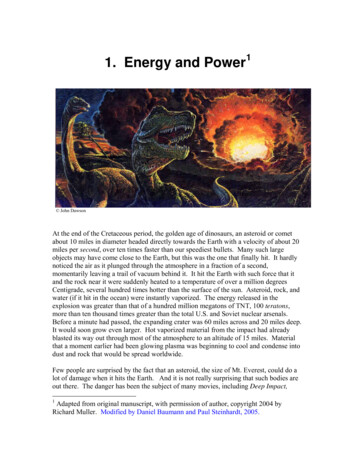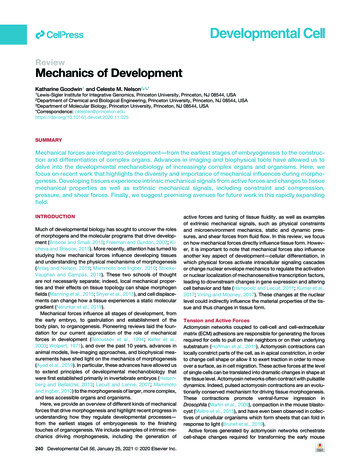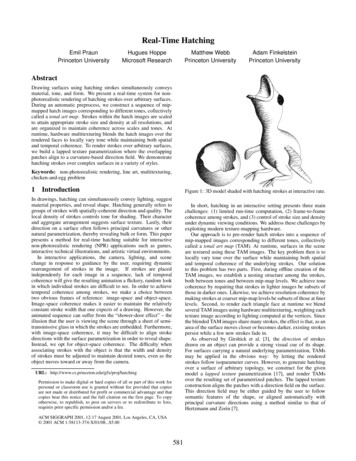
Transcription
1. Energy and Power1 John DawsonAt the end of the Cretaceous period, the golden age of dinosaurs, an asteroid or cometabout 10 miles in diameter headed directly towards the Earth with a velocity of about 20miles per second, over ten times faster than our speediest bullets. Many such largeobjects may have come close to the Earth, but this was the one that finally hit. It hardlynoticed the air as it plunged through the atmosphere in a fraction of a second,momentarily leaving a trail of vacuum behind it. It hit the Earth with such force that itand the rock near it were suddenly heated to a temperature of over a million degreesCentigrade, several hundred times hotter than the surface of the sun. Asteroid, rock, andwater (if it hit in the ocean) were instantly vaporized. The energy released in theexplosion was greater than that of a hundred million megatons of TNT, 100 teratons,more than ten thousand times greater than the total U.S. and Soviet nuclear arsenals.Before a minute had passed, the expanding crater was 60 miles across and 20 miles deep.It would soon grow even larger. Hot vaporized material from the impact had alreadyblasted its way out through most of the atmosphere to an altitude of 15 miles. Materialthat a moment earlier had been glowing plasma was beginning to cool and condense intodust and rock that would be spread worldwide.Few people are surprised by the fact that an asteroid, the size of Mt. Everest, could do alot of damage when it hits the Earth. And it is not really surprising that such bodies areout there. The danger has been the subject of many movies, including Deep Impact,1Adapted from original manuscript, with permission of author, copyright 2004 byRichard Muller. Modified by Daniel Baumann and Paul Steinhardt, 2005.
Meteor, and Armageddon. Asteroids and comets frequently come close to the Earth.Every few years, there is a newspaper headline about a "near miss" in which an objectmisses the Earth by "only a few million miles." (That is hardly a near miss. The radiusof the Earth is about 4000 miles. So a miss by, say, four million miles would be a missby a thousand Earth radii. Compare this to the distance from the Earth to the Moon whichis about 60 Earth radii.)Although the probability of an asteroid impact during your lifetime is small, theconsequences could be huge, with millions (or maybe even billions) of people killed. Forthis reason, the US government continues to sponsor both asteroid searches (to identifypotential sources of impactor) and research into ways to deflect or destroy such bodies.But why should an asteroid impact cause an explosion? The asteroid was made of rock,not dynamite. And why such a big explosion? But then -- what is an explosion, after all?Explosions and EnergyAn explosion occurs when a great deal of stored energy is suddenly converted into heat ina confined space. The hot gas has enormous pressure, that is, it puts a great force oneverything that surrounds it. The gas expands rapidly and pushes anything near it out ofthe way. The flying debris is what we call an explosion. It doesn't matter what theoriginal form of the energy is; it could be kinetic energy (the result of motion) like theenergy of the asteroid, or chemical energy like the energy in the explosive TNT(trinitrotoluene). It is the rapid conversion of this energy into heat that is at the heart ofthe explosion.You may have noticed that we used a lot of common terms in the previous paragraph thatwe didn't explain. Words such as energy and heat have everyday meanings, but they alsohave precise meanings when used in physics. Physics can be derived in a deductive waystarting from precise definitions, just like geometry, but it is hard to learn in that manner.So our approach will be to start with intuitive definitions, and then make them moreprecise as we delve deeper into the physics. Here are some beginning definitions that youmay find helpful. The precise meanings of these definitions will become clearer over thecourse of the next three chapters.DEFINITIONSEnergy is the ability to do work. (Work is defined numerically as the magnitude of aforce multiplied by the distance the force moves in the direction of the force.)Alternative Definition for Energy: anything that can be turned into heat. 22In some cosmological models, virtually all energy will eventually be converted into heatand the heat energy cannot always be converted back to other forms. This idea,
Heat is something that raises the temperature of a material, as measured by athermometer.Those definitions are difficult to understand, since they involve other concepts (work,force, heat) that we haven’t yet defined. I’ll talk more about all these concepts in thecoming pages. In fact, it is very difficult to understand the concept of energy just from thedefinitions alone. Trying to do so is like trying to learn a foreign language bymemorizing a dictionary. So be patient. I’ll give lots of examples, and those will helpyou to feel your way into this subject.Amount of EnergyBefore we get too abstract, let’s get a sense of the amount of energy in different objects.To make the comparison fair, let each object weigh one gram. 3 Table 1.1 shows themasses of some common objects in grams.Table 1.1: Weights of common objects in grams1 cubic centimeter of water1 penny1 nickel coincup of watera pound of anythingsmall elephant, small car,tongue of small Blue Whale1 gram3 grams5 grams227 grams454 grams1,000,000 grams 1 metric ton 1.1 English tonsThe gram system is used extensively outside the United States. A thousand grams iscalled a kilogram, or just a kilo, for short. Think of a kilogram as something that weighsabout 2 pounds; the more precise conversion factor is 2.205.Remember: 1 kg weighs about 2 lbsIn Europe, you buy meat and vegetables by the kilo. By law, NASA officially useskilograms instead of pounds. This was enacted in an attempt to get Americans to bemore compatible with the measurement systems of Europe and most of the rest of thesometimes called the “heat death,” has spawned numerous essays by philosophers andtheologians.3Technical note, meant for those who have already studied some physics: We are notgoing to distinguish between mass and weight until we discuss gravity. By a weight ofone gram, we mean the weight of an object whose mass is one gram. This is theconventional non-technical usage, e.g. in European supermarkets, which sell food by thekilo.
world. You need to be familiar with both the systems. A confusion in 1999 resulteddirectly in the loss of a 125 million dollar Martian Space Probe. 4Note that a "ton" is a useful unit. There is only a 10% difference between the English ton(used in the US and Britain) and the metric ton (used almost everywhere else). Weusually won't bother to distinguish them. Remember the following: a ton is a milliongrams.The next table, Table 1.2, gives the amount of energy in one gram of different materials.You'll find that this table is one of the most interesting tables in this entire textbook, andit is worth pondering and studying. It is full of surprises.The table gives the energy in Calories (Cal), also known as "food Calories" (listed oncontainers of food), and it also gives the energy in a scientific unit known as the "joule."Calories are familiar; joules are worth learning. One Calorie is about 4200 joules 4.2kJ (where a kJ kilojoule 1000 joules) 5 . A typical human eats food every day thatsupplies about 2000 Calories of energy. You can barely survive on about 1000 Caloriesper day, 6 and you'll get overweight if you eat 3000 Calories per day (as many Americansdo) unless you are engaged in manual labor or active on a sports team. The Sumowrestlers of Japan are reputed to eat 20,000 Calories per day.Remember: 1 food Calorie 4 kilojoulesMore technically, a Calorie is defined as the amount of energy that it takes to heat akilogram of water by 1 degree C ("Celsius" or “Centigrade”), a temperature change equalto 1.8 degrees F ("Fahrenheit"). To make comparisons easier, the Table 1.2 lists not onlyenergy per gram, but its ratio to the energy contained in the explosive TNT(trinitrotoluene). I’ll talk more about temperature scales in Chapter 2.4A confusion between the metric system and the U.S. system cost us a 125 millionMartian Space Probe in 1999. NASA was using the metric system, but Lockheed-Martin,one of the contractors, had designed their subsystem to use some "standard" US/Britishunits (feet, inches, pounds). The incompatibility wasn't noticed until the satellite failed toland properly on Mars. For reference, ic.02/.5A more precise number is that 1 Calorie contains 4184 joules 4.184 kJ. However, it ismore important to remember that it is approximately four thousand, than to memorize theprecise number. You'll find as you work in this course, that the conversion betweenCalories and joules will be something you do over and over. Calories are good unitsbecause you come across them in food, and therefore you have some familiarity withthem. Joules are used almost exclusively in physics.6If you consume only 1000 Calories per day, biologists find that aging slows downsignificantly. Unfortunately, you tend to be very listless and inactive, so the gain inlifespan is not particularly worthwhile.
Beware: If you have taken a course in biology, chemistry, or physics, you may haveencountered an energy unit called a calorie spelled with a small c. One calorie (cal) is1/1000 of a food Calorie (Cal). This is a terrible convention. To distinguish the two, thefood Calorie should always be capitalized, although in popular writing—including thenutrition information on food-can labels—it often is not. But for us, 1 Cal 1000 cal 1kilocalorie 4.2 kJ.Table 1.2: Relative EnergyObjectbullet (moving at speed ofsound, 1000 ft per second)battery (flashlight)battery (computer)TNT (trinitrotoluene)modern High Explosive (PETN)chocolate chip cookiesbuttergasolinemethane gas (CH4)hydrogen gas (H2) for fuel cellasteroid or meteor (30 km/sec)uranium-235Energy in one gramCaloriesJoules0.01 Cal40 Jcompared toTNT0.0150.01 Cal0.1 Cal0.651 Cal1.06 Cal5 Cal710 Cal13 Cal26 Cal107 Cal20 million Cal0.0150.1511.681115204016530 million400 J2723 J21 kJ29 kJ42 kJ54 kJ110 kJ450 kJ84 billion JStop reading now, and ponder the table of energies. Look for the numbers that aresurprising. How many can you find? (My answers are in the next paragraph.)All of the following are surprises:the very large amount of energy in chocolate chip cookies, compared to TNTthe very small amount of energy in a battery, compared to gasolinethe high energy in a meteor, compared to a bullet or to TNTthe enormous energy available in uranium, compared to anything else in the table.Try some of these facts on your friends. Even most physics majors will be surprised.These surprises and some other features of the table are worthy of further discussion.
Discussion of the Table of Relative EnergiesLet's pick out some of the more important and surprising facts shown by Table 1.2 anddiscuss them in more detail.TNT vs. Chocolate Chip Cookies.Both TNT and chocolate-chip cookies store energy in the forces between their atoms.(We'll discuss atoms in the next chapter.) Some people like to refer to such energy aschemical energy, although this distinction isn't really important. When TNT is exploded,the forces push the atoms apart at very high speeds.One of the biggest surprises in the Energy Table 1.2 is that chocolate chip cookies(CCCs) have eight times the energy as the same weight of TNT. How can that be true?Why can’t we blow up a building with CCCs instead of TNT? Almost everyone whohasn't studied the subject assumes (incorrectly) that TNT releases a great deal moreenergy than cookies.What makes TNT so useful for destructive purposes is that it can release its energy —transfer its energy into heat — very very quickly. The heat is so great that the TNTbecomes a gas that expands so rapidly that it pushes and shatters surrounding objects.(We'll talk more about the important concepts of force and pressure in the next chapter.)A typical time for 1 gram of TNT to release all of its energy is about one millionth of asecond. Such a sudden release of energy can break strong materials. 7Even though chocolate chip cookies contain more energy than a similar weight of TNT,the energy is normally released more slowly, through a series of chemical processes thatwe call metabolism. This requires several chemical changes (e.g. resulting from mixingthe food with acid in the stomach and with enzymes in the intestines), and finally thereaction of the food with oxygen (taken in by the lungs and stored in red blood cells).(Cells use complex chemical pathways to draw out the conversion of glucose into energy(ATP) over time because rapid release would heat up the cell and destroy it.) In contrast,TNT contains all the molecules it needs to explode; it needs no mixing, and as soon aspart of it starts to explode, that triggers the rest. If you want to destroy a building, you cando it with TNT. Or you could hire a group of teenagers, give them sledge hammers, andfeed them cookies. Since the energy in chocolate chip cookies exceeds that in an equalweight of TNT, each gram of chocolate chip cookies will ultimately do more destructionthan would each gram of TNT.Note: When we say there are 5 Cal per gram in CCCs, we are ignoring the air. WhereasTNT contains all the chemicals needed for an explosion, CCCs need to combine with air,and although air is "free", part of the reason that CCCs contain so much energy per gram7As we'll see in Chapter 3, to calculate the force, you can take the energy and divide it bythe distance over which it is released (from chemical to kinetic energy).
is that the weight of the air was not counted. If we were to include the weight of the air,the energy per gram would be lower, about 2.5 Calories per gram, but still much greaterthan for TNT.GasolineAs Table 1.2 shows, gasoline contains more energy per gram than any other everydaysubstance. That's why it is so valuable as fuel. Gasoline releases its energy (turns it intoheat) by combining with oxygen, and so it must be well-mixed with air to explode. In anautomobile, this is done by a special device known as a fuel injector. (Older cars usesomething called a carburetor.) The explosion takes place in a cylindrical cavity known,appropriately, as the cylinder. The energy released from the explosion pushes a pistondown the axis of the cylinder, and that is what drives the wheels of the car. An "internalcombustion engine" can be thought of as an "internal explosion engine." 8 The muffler ona car has the job of making sure that the sound from the explosion is muffled, and not toobothersome. Some people like to remove the muffler (especially some motorcyclists) sothat the full explosion is heard; this can give the illusion of much greater power.(Removing the muffler also lowers the pressure just outside the engine, so that the powerto the wheels is actually increased, although not by very much.) We'll talk more about thegasoline engine in the next chapter.Batteries vs. GasolineA battery also stores its energy in chemical form. It can use its energy to releaseelectrons from atoms (we'll discuss this more in Chapters 2 and 6). Electrons can carrytheir energy along metal wires, and deliver their energy at another place. (Think of wiresas pipes for electrons.) The chief advantage of electric energy is that it can be easilytransported along wires, and converted to motion with an electric motor.Table 1.2 shows that gasoline contains 1000 times as much energy per gram as in aflashlight battery, and 100 times as much as in an expensive computer battery. Thosefacts explain why most automobiles use gasoline instead of batteries as their source ofenergy. (Batteries are used to start the engine.) A typical car carries about 100 lb ofgasoline. To carry that much available energy in batteries would take 100 times thatweight (10000 lb 5 tons), much more than the total weight of a typical car. That's notan attractive option, even if the batteries were cheap. But batteries have advantages insome circumstances. In World War II, when submarines had to submerge (and could not8Engineers like to make a distinction between an explosion, in which an abrupt frontcalled a “shock wave” is generated which passes through the rest of the material andignites it, and a “conflagration”, in which there is no shock wave. There is no shockwave in the detonation of gasoline in an automobile, so by this definition, there is noexplosion in an automobile engine. Newspapers and the general public do not make thisfine distinction, and in this book, neither will I.
obtain oxygen), their energy source was a huge number of batteries stored beneath thedecks. When on the surface, or “snorkeling depth”, the submarines ran on diesel fuel, aform of gasoline. The diesel fuel also ran generators that recharged the batteries. Soduring WWII, most submarines spent most of their time on the surface, recharging theirbatteries.Hybrid AutomobilesDespite the limitations of batteries, there is a fascinating new technology called “hybridautomobiles”. In a hybrid, a small gasoline engine provides energy to charge a battery;the car then gets its energy from the battery. This has more value than you might guess:the gasoline engine can be run at a constant rate, under ideal conditions, and as a result, itis two to three times as efficient as the engine in ordinary cars. In addition, hybridengines can convert some of the mechanical motion of the automobile (e.g. its extraspeed picked up when descending a hill) back into stored chemical energy in therechargeable battery. Hybrid engines are becoming very popular, and in a few years,they may be the most common type of automobile, particularly if gasoline prices rise.Figure 1.1. Engine of a hybrid automobile (Honda Civic).A small gasoline engine surrounded by batteries.(from http://www.insightman.com/press kit 1.htm)Hydrogen vs. Gasoline -- and the Fuel CellNotice from Table 1.2 that hydrogen gas has 2.6 times more chemical energy per gramthan gasoline. Popular articles about the future “hydrogen economy” are partially basedon this fact. In 2003, President George W. Bush announced a major program with thegoal of making hydrogen into a more widely-used fuel.Another attractive feature of hydrogen is that the only waste product it produces is water,created when the hydrogen (H) is chemically combined with oxygen (0) from the air to
make H2O (water). This can be done using an advanced technology called a fuel cell toconvert the chemical energy directly into electricity.A fuel cell looks very much like a battery, but has a distinct advantage. In a battery, oncethe chemical is used up, you have to recharge it with electricity produced elsewhere, orthrow it away. In a fuel cell, all you have to do is provide more fuel (e.g. hydrogen andoxygen). Perhaps you’ve seen a demonstration of “electrolysis” in which electricity ispassed between two terminals through water, and hydrogen and oxygen gas are producedat the terminals. A fuel cell is a very similar device, but run backwards. Hydrogen andoxygen gas are compressed at the electrodes, they combine to form water, and electricityflows through wires that connect one terminal to the other.The main technical difficulty of the hydrogen economy is that hydrogen is not verydense. Even if liquefied, it has a density of only 0.071 grams per cubic centimeter (cc), afactor of 10 less than gasoline. As we saw in the Energy Table 1.2, per gram hydrogenhas 2.6 times more energy than gasoline. Put these together, and we find that a gallon ofliquid hydrogen stores only 101 2.6 14 as much energy per cubic centimeter (or pergallon) as gasoline, a factor of 4 worse. Many experts say the factor is only 3 timesworse, since hydrogen can used more efficiently than gasoline. It is useful to rememberthe following approximate numbers; you will find them valuable when discussing thehydrogen economy with other people:Liquid hydrogen (compare to gasoline) has3 more energy per gram (or lb)3 less energy per gallon (or cubic centimeter).
Nevertheless, it is still possible we will be driving hydrogen-driven cars in the nearfuture. It is also possible that hydrogen will be more valuable as a fuel for airplanes,since for these the low weight of the hydrogen may be more important than the fact that ittakes more volume than gasoline.A technical difficulty with liquid hydrogen is that it boils at a temperature of –423degrees F. This means that it must be transported in special thermos bottles (technicallyknown as dewars). Alternatively, it can be transported in a form in which it is chemicallyor physically combined with other materials at room temperature (although that greatlyincreases the weight per Calorie). A more practical alternative may be to transport it ascompressed gas, but then the weight of the pressure tank actually exceeds the weight ofthe hydrogen carried.Where does the hydrogen come from? There is virtually no free hydrogen gas (or liquid)in the environment; it must be manufactured, and that takes energy. A typical hydrogenproduction plant of the future would start with a power plant fueled by coal, gasoline,nuclear fuel, or solar energy. That power plant might use this energy to convert ordinarywater into hydrogen and oxygen (through a process called electrolysis, or though a seriesof chemical reactions known as steam reforming). Then, for example, the hydrogencould be cooled until it is turned into a liquid, and then transported to the consumer.Thus:Hydrogen is not a source of energy.It is a means for transporting energy.Many people who favor the hydrogen economy believe that the source of hydrogen willbe methane gas (CH4). When methane is heated with water to high temperatures, thehydrogen in the methane is released, along with carbon dioxide (CO2). Since carbondioxide is considered an air pollutant, this method of production may not be optimal, butit is probably the cheapest way to make hydrogen.Although the fuel cell produces no pollution (only water), it is not quite right to say that ahydrogen-based economy is pollution-free unless the plant that used energy to producethe hydrogen is also pollution-free. Nevertheless, the use of hydrogen as a fuel isexpected to be environmentally less harmful than gasoline for two reasons: the powerplant can, in principle, be made more efficient than the automobiles; and the power plantcan have more elaborate pollution-control devices than an automobile. Other people likethe idea of hydrogen as fuel because it moves the sources of pollution away from thecities, where the high concentration of pollutants can be more dangerous to human health.Of course, it is hard to predict all environmental effects. In June 2003 someenvironmentalists argued that significant hydrogen gas could leak into the atmosphereand drift to high altitudes. There it could combine with oxygen to make water vapor, andthat could affect both the Earth's temperature and delicate atmospheric structure such asthe ozone layer (see chapters 8 and 10).
The United States has enormous coal reserves (about 2 trillion tons known; twice asmuch is estimated), They could be used to produce all the energy that we would need (atcurrent consumption rates) for hundreds of year. Of course, the environmentalconsequences, from strip mining and CO2 production could be very large.Gasoline vs. TNTIn most movies, when a car crashes, it explodes. Does this happen in real life? Have youever witnessed the scene of a car crash? Had an explosion taken place? The answer is:usually not. Unless mixed with air in just the right ratio (done in the automobile by thefuel injector or carburetor) gasoline burns but doesn't explode.In the Spanish revolution, the rebels invented a device that later became known as a"Molotov cocktail." It was a bottle filled with gasoline, with a rag stuck in the neck.The rag was soaked with gasoline, ignited, and then the bottle was thrown at the enemy.It broke upon impact. It usually didn't explode, but it spread burning gasoline, and thatwas pretty awful to the people who were the targets. This weapon quickly achieved astrong reputation as an ideal weapon for revolutionaries.I hesitate to give examples from the unpleasant subject of war, but it is important tofuture presidents and citizens to know of these. On Nov. 6, 2002, the US starteddropping 15,000 lb “fuel-air explosives” on Taliban soldiers in Afghanistan. You canprobably guess that this was a liquid fuel similar to gasoline. The fuel is dropped from anairplane, and descends slowly on a parachute. As it near the ground, a small charge ofhigh explosive (probably only a few pounds worth) explodes in the center, dispersing thefuel and mixing it with air – but not igniting it. Only when the fuel is spread out and wellmixed with air, it is ignited by a second explosion. The explosion is spread out over alarge area, so it doesn't exert the same kind of intense force that it takes to break though aconcrete wall, but it has enough energy released to kill people and other "soft" targets.What makes it so devastating is the fact that 15,000 lbs of fuel, like gasoline, contains theenergy equivalent of 225,000 lbs of TNT. So although 15,000 lbs sounds bad, in fact it ismuch worse than it sounds. Once the soldiers had seen the fuel-air explosive from adistance, the mere approach of a parachute induced panic.Uranium vs. TNTThe most dramatic entry in the table is the enormous energy in the form of uraniumknown as U-235: 30 million times that of TNT. We will discuss this in detail in chapters4 and 5. For now, there are only a few important facts to know. The source of energy isthe enormous forces inside the atom’s nucleus. For most atoms, this energy cannot beeasily released, but for U-235 (a special kind of uranium that makes up only 0.7% ofnatural uranium), the energy can be released through a process called a “chain reaction”(discussed in detail in Chapter 5). This enormous energy release is the principle behind
nuclear power plants and atomic bombs. Plutonium (the kind known a Pu-239) is anotheratom capable of releasing such huge energy.Compared to gasoline, U-235 can release 1.5 million times as much energy per gram.Compared to chocolate-chip cookies, it releases about 0.75 million times as much. Thefollowing approximation is so useful that it is worth memorizing:Nuclear processes release about 1 milliontimes as much energy as chemical processes(food), per gram.Forms of EnergyWe have talked about food energy and chemical energy. The energy in a moving bulletor asteroid is called energy of motion, or kinetic energy. The energy stored in acompressed spring is called stored or potential energy. (Despite its name, potentialenergy does not mean that it is something that can “potentially” be converted to energy;potential energy is energy that is stored, just as food that is stored is still food.) Nuclearenergy is the energy stored in the forces between parts of the atomic nucleus, releasedwhen the nucleus is broken. Gravitational energy is the energy that an object has at highaltitude; when it falls, this energy is converted into kinetic energy. As we will discuss inChapter 2, the heat in an object is a form of energy. All these energies can be measured inCalories or Joules.Many physics texts like to refer to chemical, nuclear, and gravitational energy as differentforms of potential energy. This definition lumps together in one category all the kinds ofenergy that depend on shape and position, e.g. whether the spring is compressed, or howthe atoms in a chemical are arranged. This lumping is done in order to simplifyequations; there is no real value in doing it in this text, as long as you realize that allenergy is energy, regardless of its name.In popular usage, the term energy is used in many other ways. Tired people talk abouthaving "no energy." Inspirational speakers talk about the "energy of the spirit." Theyhave the right to use energy in these non-technical ways. Physicists stole the wordenergy from the English language and then redefined it in a more precise way. Nobodygave physicists the right to do this. But it is useful to learn the precise use, and to be ableto use it in the way physicists do. Think of it as "physics as a second language." Themore precise definition is useful when discussing physics.In the same precise physics language, power is defined as the energy used per second. Itis the rate of energy release. In equation form:Power Energy.Time
Note that in popular usage, the terms of power and energy are often used interchangeably.(You can find examples of this if you pay attention when reading newspaper articles.) Inour precise use of these terms, however, we can say that the value of TNT is that eventhough it has less energy per gram than chocolate chip cookies, it has greater power(since it can convert its limited energy to heat in a few millionths of a second). Ofcourse, it can’t deliver this power for very long, because it runs out of energy.The most common unit for power is the watt (named after James Watt, the inventor of thesteam engine, the most powerful motor of its time, and the "high tech" of the 1700s). Thewatt is defined as one joule per second:1 watt 1 W 1 joule per second1 kW 1 kilowatt 1000 joules per secondYou'll find that the term kilowatt is usually abbreviated as "kW" since Watt is a person'sname. But for some mysterious reason, the term "watt" is usually not capitalized. Thesame logic applies to the joule and the kilojoule (abbreviated kJ).There is a physics joke about the watt, inspired by an Abbott and Costello routine called"Who's on First" about baseball names. See the footnote. 9 The original "Who's on First"routine is available on the inte
Every few years, there is a newspaper headline about a "near miss" in which an object misses the Earth by "only a few million miles." (That is hardly a near miss. The radius of the Earth is about 4000 miles. So a miss by, say, four million miles would be a miss by a thousand Earth radii. Comp










